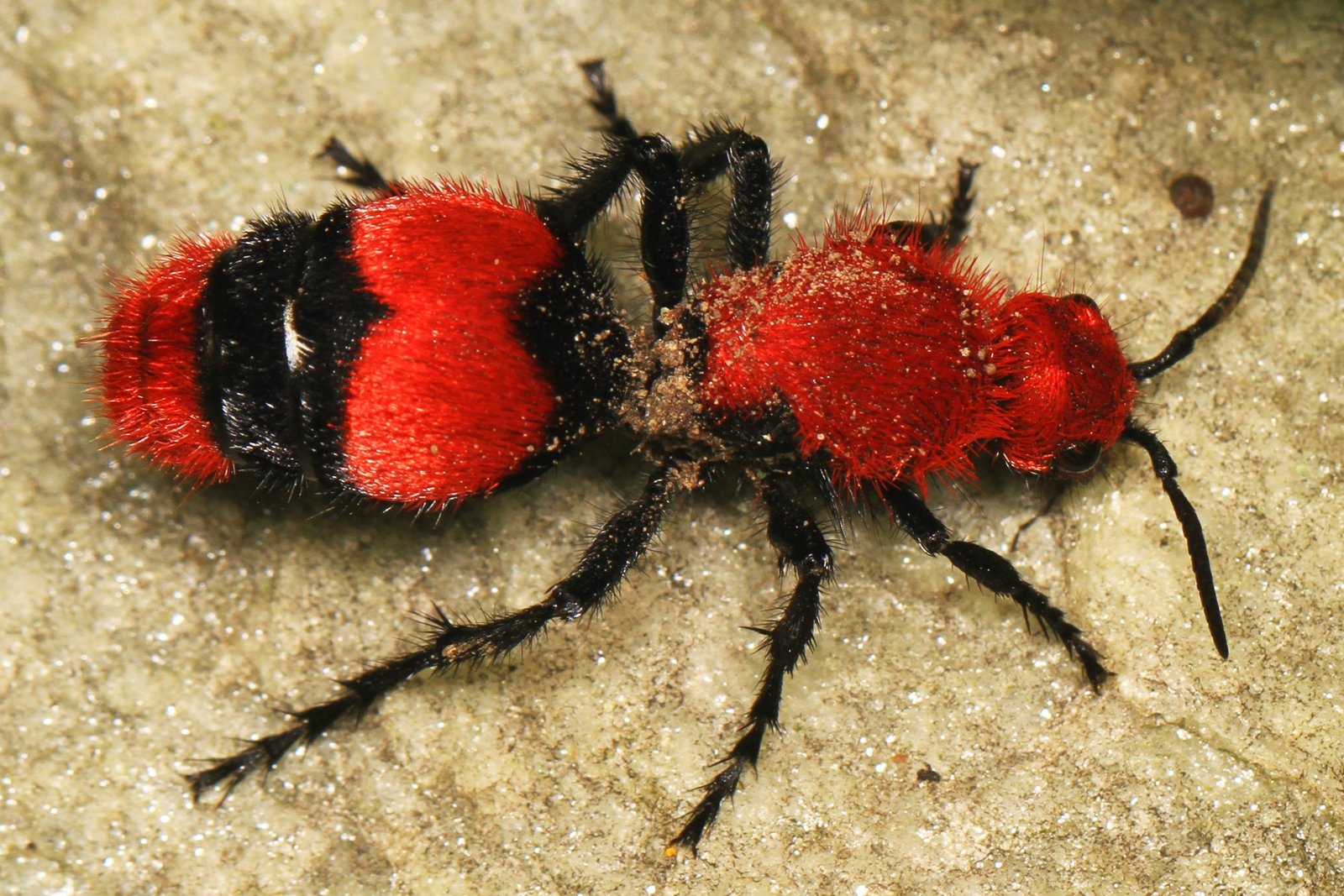Velvent Ant: Mutillidae

Description Of The Velvent Ant
Velvent ants (AKA cow killer ant) are actually wasps, not ants. Females velvent ants are wingless and covered with dense hair, resembling ants superficially. The largest velvet-ant species, which measures about 3/4 inches in length, is the red velvet-ant. They are mostly black with patches of orange or red hair on the abdomen and thorax. Males are comparable, but they have wings and are unable to sting.
In North America, several other velvet ant species are common, including the gray velvet ant or mutillid down thistle. Most of them are immature wasp solitary parasites (Vespidae and Sphecidae), solitary bees, and other insects such as beetles or flies. It’s possible to confuse winged males with other Hymenoptera. Tiphiid Wasp adults, 3/4 inch long, are black and yellow. 1Go To Source texasinsects.tamu.edu -“Red Velvet Ant or “Cow Killer””
Learn More: Stinging Insect Identification
Velvent Ant Behavior

In search of females to mate, males fly constantly. The mated woman enters a ground-nesting bee or wasp nest and lays her eggs on or near the other insect’s larvae. When the larvae of the velvet ant emerge from the eggs, the host’s larvae feed on them, killing them. That is why they are regarded as parasitoids.
Velvet ants, as adults, feed on nectar. Although it is not possible for the female cow killer to fly, it has many defenses. They are fast movers, have a very solid exoskeleton, and can release smelly odors in addition to bright warning colors and squeaking warning sounds.
Furthermore, women are able to deliver an excruciating sting. Females have a large, retractable stinger called the ovipositor, which is a modified egg-laying organ. 2Go To Source newsroom.unl.edu -“PESTS & WILDLIFE — Cow killer ant: Wrongfully accused”
Life Cycle Of Velvent Ants
Offspring, most often larvae of other wasps and bees, develop as parasites of other immature insects. In the cells of the host, velvet ants that attack bees and wasps place their eggs. These nests are often forcibly entered by the female velvet ant, and the velvet ant may remain for several days in the nest.
The eastern velvet ant, Dasymutilla occidentalis parasitize bumblebee nests, is the largest and most brightly colored species of velvet ant in the United States. Other species of velvet ants, for instance, parasitize cicada killer wasps. 3Go To Source nature.mdc.mo.gov -“VELVET ANTS Nearly 500 species in North America north of Mexico”
Velvent Ant Defense Mechanisms

Thanks to a few defense mechanisms that allow them to walk freely along with the land without fear of predators, velvet ants may be invulnerable to attacks.
Velvet ants have several defense mechanisms that prevent predators, including a painful sting that has earned the “cow killer” nickname.
A tough outer skeleton that can not be pierced and foul-smelling chemical excretions also work to avoid attacks. Many animals will get the velvent any into their mouth but spit the insect out once they have been stung. 4Go To Source earth.com -“Velvet ants are essentially invincible due to effective defenses”
Habitat Of The Velvent Ant
Typically, female cow killer ants are seen running somewhat erratically on the ground, particularly in the warm summer months in bare or sandy areas. Occasionally, these pests will enter insect prey structures. There are often male velvet ants found on flowers, although some species are nocturnal.
Velvent Ant Range & Distribution
There are approximately 230 genera/subgenera and about 8,000 species in the Mutillidae family worldwide. In most arid areas of the southern and western parts of North America, approximately 435 species exist. 5Go To Source entnemdept.ufl.edu -“common name: velvet ants”
Diet Of Velvent Ants
Adult cow killer ants feed primarily on nectar, but also larvae and adult insects such as flies, beetles, bees, and other wasps, will also be eaten.
Velvent Ants & Human Interaction
Although velvet ants are very docile and hardly come in contact with individuals, there is a potent and toxic venom in the female velvet ant. Generally, a sting only happens if it is stepped on accidentally. If a sting happens, some individuals are likely to have a severe allergic reaction that will require immediate medical attention. Parents should educate their kids not to touch or handle them.
Sources:
- “Red Velvet Ant or ‘Cow Killer.’” Texas A&M AgriLife Extension, Texas A&M University, texasinsects.tamu.edu/red-velvet-ant-or-cow-killer/#:%7E:text=Description%3A%20These%20insects%20are%20wasps,on%20the%20thorax%20and%20abdomen. Accessed 10 Feb. 2021.
- Green, Jody. “PESTS & WILDLIFE — Cow Killer Ant: Wrongfully Accused | Announce | University of Nebraska-Lincoln.” University Of Nebraska- Lincoln, University Of Nebraska, 22 Aug. 2018, newsroom.unl.edu/announce/lancasterextension/8281/47757.
- MDC Staff. “Velvet Ants.” MDC Discover Nature, State Of Missouri, nature.mdc.mo.gov/discover-nature/field-guide/velvet-ants#:%7E:text=Habitat%20and%20conservation,one%20abdominal%20segment%20against%20another. Accessed 10 Feb. 2021.
- Vandette, Kay. “Velvet Ants Are Essentially Invincible Due to Effective Defenses •.” Earth.Com, Earth.com, 3 July 2018, www.earth.com/news/velvet-ants-invincible.
- Hertz, Jeffrey. “Mutillidae – Velvet Ants.” The University Of Florida IFAS, University of Florida, Mar. 2007, entnemdept.ufl.edu/creatures/misc/wasps/mutillidae.htm.
